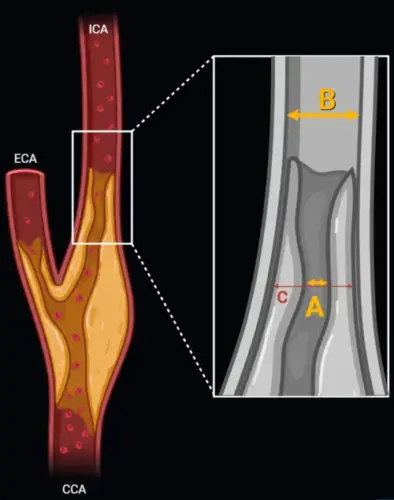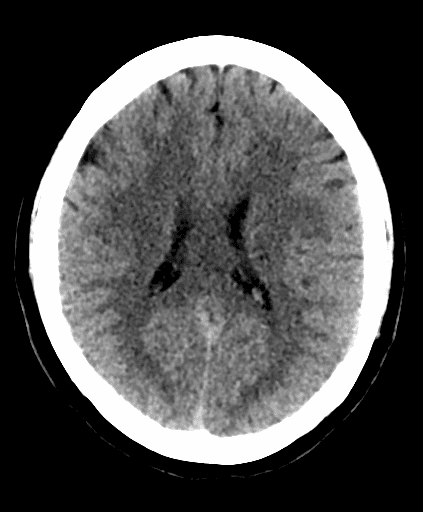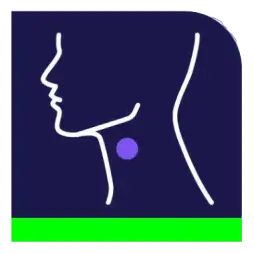NASCET Calculator for CTA & MRA + Report Generator

References:
- North American Symptomatic Carotid Endarterectomy Trial Collaborators, Barnett, H. J. M., Taylor, D. W., Haynes, R. B., Sackett, D. L., Peerless, S. J., Ferguson, G. G., Fox, A. J., Rankin, R. N., Hachinski, V. C., Wiebers, D. O., & Eliasziw, M. (1991). Beneficial effect of carotid endarterectomy in symptomatic patients with high-grade carotid stenosis. The New England journal of medicine, 325(7), 445–453. https://doi.org/10.1056/NEJM199108153250701
- Randomised trial of endarterectomy for recently symptomatic carotid stenosis: final results of the MRC European Carotid Surgery Trial (ECST). (1998). Lancet (London, England), 351(9113), 1379–1387.
Related Calculators:
More About the ECST and NASCET Calculator
Background on the NASCET and ECST Trials
The North American Symptomatic Carotid Endarterectomy Trial (NASCET) and the European Carotid Surgery Trial (ECST) are well known studies that contributed to current approaches for evaluating carotid artery disease. Both trials were performed at a time when the benefits of carotid endarterectomy were being carefully evaluated. Their findings helped clarify which patients were more likely to benefit from surgical intervention and informed later clinical guidelines.
NASCET was conducted primarily in North America and relied on angiographic measurements with clearly defined inclusion criteria. Patients had recent symptoms related to cerebral ischemia, and internal carotid artery stenosis was graded using a standardized distal reference. ECST, carried out in Europe, used a different measurement approach that estimated the original arterial diameter at the site of disease. Although the methodologies differed, both trials reported benefit from surgery in patients with higher degrees of symptomatic stenosis.
These studies also influenced how imaging findings are described in clinical practice. The NASCET and ECST calculators are commonly used to express stenosis severity in a consistent way and to relate imaging measurements to published clinical data.
The NASCET Method
The NASCET trial evaluated patients with symptomatic internal carotid artery stenosis and compared surgical treatment with medical management. The results showed a reduction in ipsilateral stroke risk among certain patients who underwent carotid endarterectomy, particularly those with higher degrees of narrowing. Patients with moderate stenosis appeared to have a smaller and more variable benefit, highlighting the importance of clinical judgment.
A key feature of NASCET was stratification by degree of stenosis. This approach helped clarify that treatment decisions should not rely on a single cutoff but should consider both imaging findings and patient factors.
The NASCET calculation is defined as:
Stenosis (%) = [1 - (narrowest diameter / distal ICA diameter)] × 100
The distal internal carotid artery beyond the bulb is used as the reference point. This helps reduce variability related to plaque shape or bulb anatomy. The method is widely applied in radiology reporting and can be used with DSA, CTA, and MRA when image quality is adequate.
In routine practice, the NASCET percentage provides a shared reference that supports communication among radiologists, neurologists, and vascular specialists.
The ECST Method
The ECST trial also evaluated surgical treatment in patients with symptomatic carotid artery disease but used a different approach to measurement. ECST estimated percent stenosis by comparing the narrowest lumen to the presumed original diameter of the artery at the site of disease. This estimate is based on vessel contours rather than a distal reference segment.
Because of this difference, ECST measurements often produce higher percentage values than NASCET for the same lesion. For example, a stenosis graded as 70 percent by ECST may correspond to a lower percentage when calculated using NASCET criteria. This distinction is important when interpreting older studies or comparing results across regions.
While ECST measurements are less commonly used in current radiology reports, they remain relevant for understanding historical data and certain European publications. Including both methods in a calculator can help users place measurements into the appropriate context.
Why the NASCET Calculator Is Used in Practice
In clinical settings, this calculator provides a quick way to express stenosis severity using a familiar framework. It may be used in acute settings, such as stroke evaluation, as well as in outpatient follow up of known carotid disease.
Common uses include:
- Consistency: Helps align reporting among different clinicians and services.
- Efficiency: Allows percent stenosis to be calculated without manual formulas.
- Clinical context: Supports discussion of treatment options when stenosis falls within moderate or borderline ranges.
- Education: Assists trainees in learning proper measurement technique and anatomy.
- Multidisciplinary care: Provides a reference point for discussions across neurology, vascular surgery, and interventional teams.
Using the NASCET and ECST Calculator
Accurate measurements depend on careful image review:
- Identify the narrowest lumen at the point of maximal stenosis.
- Select a distal ICA reference that appears normal and free of disease, typically beyond the bulb.
Measurements should be made on high quality imaging with attention to multiplanar views. Calcification, motion, and eccentric plaques can affect accuracy, so reviewing multiple planes is helpful.
CTA generally provides reliable spatial resolution. MRA can also be used, though flow related artifacts may influence measurements in some cases. DSA may be considered when noninvasive imaging is inconclusive. Calculator results should always be interpreted in light of image quality and clinical context.
Clinical Use Beyond Endarterectomy
Although initially developed in the setting of carotid endarterectomy trials, the NASCET method is now applied more broadly. It is also used when evaluating patients for carotid artery stenting, particularly when assessing eligibility and follow up.
The reported percentage may help clinicians:
- Adjust medical therapy such as antiplatelet or lipid lowering treatment.
- Plan imaging surveillance intervals for moderate disease.
- Provide context during stroke risk assessment.
- Apply standardized criteria in research or clinical trials.
In this way, percent stenosis often functions as one component of longitudinal cerebrovascular care.
Limitations and Interpretation Considerations
The NASCET method has recognized limitations. It assumes the presence of a normal distal reference segment, which may not be available in patients with diffuse disease. Selecting an appropriate reference can be challenging and may affect the final percentage.
Percent stenosis also does not account for other features that may influence risk, such as:
- Plaque characteristics: Ulceration or hemorrhage may carry additional risk.
- Intraluminal thrombus: May indicate plaque instability.
- Hemodynamic factors: Collateral flow and perfusion status vary between patients.
Patient specific factors including age, comorbidities, and procedural risk should always be considered alongside imaging measurements.
Putting the Evidence Into Daily Practice
The NASCET calculator provides a structured way to relate imaging measurements to published trial data. When combined with clinical assessment, it can support thoughtful decision making and clear communication.
As imaging techniques and guidelines continue to evolve, the core measurement concepts from NASCET and ECST remain relevant. Whether assessing symptomatic disease or monitoring asymptomatic stenosis, standardized calculations can help place findings into a familiar clinical framework.
Frequently Asked Questions
- What do NASCET and ECST stand for?
NASCET refers to the North American Symptomatic Carotid Endarterectomy Trial. ECST refers to the European Carotid Surgery Trial. - Why do the two methods give different percentages?
They use different reference diameters. NASCET uses a distal normal segment, while ECST estimates the original vessel diameter at the lesion. - Which method is commonly used today?
Most contemporary guidelines and radiology reports use NASCET. ECST is mainly encountered in older studies or specific European literature. - How reliable are CTA and MRA for these measurements?
CTA generally provides good spatial detail. MRA can also be useful, though artifacts may affect accuracy in some cases. - Does percent stenosis alone determine treatment?
No. Symptoms, plaque features, and patient risk factors are all important. - Can the calculator be used for asymptomatic disease?
Yes, but interpretation should follow guideline recommendations, which differ from symptomatic disease. - Is there a direct conversion between ECST and NASCET?
Only approximate relationships exist, and values can vary depending on vessel anatomy. - What is the main purpose of using a NASCET calculator?
To standardize reporting and relate imaging findings to established clinical trial criteria.






this was the best nascet calculator that i saw but no longer works. not showing the % stenosis. shame
Thank you for your feedback. Over the past few days, we have encountered occasional and temporary issues due to the relocation and upgrade of our servers. I expect the website to stabilize within a day or two. Thank you for your patience.
glad to see it back up and running. the other calculators were okay but you have to click calculate instead of doing it automatically